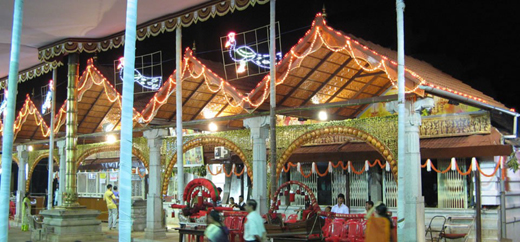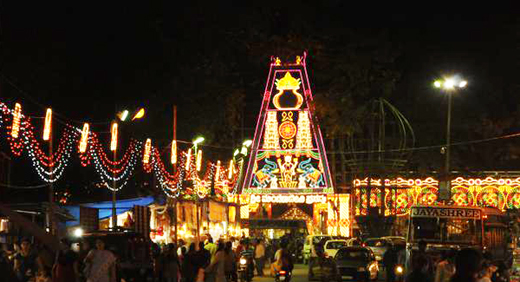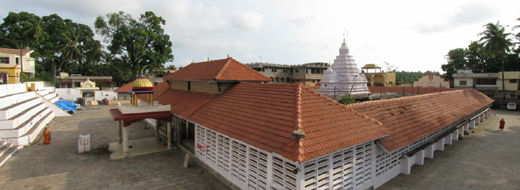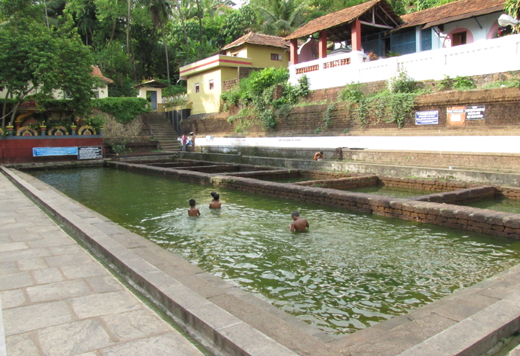Mangaladevi and Mangalore
Mangaladevi and Mangalore
Mangalore Today News Network
By I. J. Saldanha Shet
Mangalore, May 16, 2014: The auspicious name ’Mangalore’ is born of ancient names, ’Mangala-Uroo’ ’Mangalapura’ and other forms referring to the ancient deity ’ Mahatobhara Shree Mangaladevi’ whose temple is situated at Bolar in the Southern part of the city about three kilometers from the city center and can be reached from different directions. It’s location and architecture are uniquely legendary. As the crow flies it is a short distance directly east, of the confluence ’alive bagilu’, of the two treasured rivers flowing around greater Mangalore - Nethravathi and Gurpura. Before the name ’Mangaluroo’ was linked to ’Goddess Mangaladevi’, the original Tulu name ’KUDLA’ refers to the confluence of rivers, it is said. Later the Konkani settlers too adopted ’Kodial’ - both these names are still very much in use by the local population. The area hugging the banks of the rivers from Adyar in the east and Sultan Batheri in the north and further, are intrinsically bathed in mythology and history and form the ancient original town of ’Mangaluru’ - Mangalore. The land around the Mangaladevi Temple bears testimony to several hot spots of local history down the ages, and is a mosaic most intricate and valuable - materially a priceless heritage. Several immediate surrounding spots still subtly point to the historicity of the area, like ’Hale Kote’ ( first the abode of the local ruler ’Bangaraja’ and later the old Portuguese fort); ’Bathery Garden’ (once the ’Battery’ housing arms and ammunition), ’Lee-well’ ( a marine term and navigational reference point), ’Cantonment’ (British military base), ’Hoige Bazar’, ’Bunder’ and so on hold deep historic significance within their grasp.

Mahatobhara Shree Mangaladevi Temple:
’Bangaraja’ a prominent local ruler, proved a worthy successor to Veerabahu. He ruled his kingdom of Tulu Nadu well and brought glory and fame. On many nights, while he was sleeping Goddess Mangaladevi appeared in his dream and revealed to him that at the particular spot where Netravathi and Phalguni (Gurpura) rivers converge there is a mound under which lay the remains of a celestial shrine. Mother Goddess bade him to dig up the spot, obtain the relics and install the Shivashakthi Linga and the Dharapatra in a shrine to be newly built. Then, she further indicated that arrangements should be made for the regular worship in the temple. She promised him that these services would bring him and his kingdom glory and happiness. This is the early mythology of the original temple, even before the ninth century AD, worship of Goddess Mangaladevi at this spot and varying accounts always exist.
The later renovated temple is said to date back to the ninth century when Kundavarman, the famous king was ruling Tulu Nadu. At this point in time, there were two holy men of the ’Nath cult’, Machhendranath and Gorakhnath, who it is said came from the Himalayan kingdoms and set up camp along the Nethravathi River. They chose a place near the banks of the Netravathi which was once the sacred center of the sage Kapila. He had his hermitage (mutta) there and it was a great center of education it is learnt.

Hearing about the arrival of the two holy men, King Kundavarman came to meet them, he paid his respects and offered them patronage. Pleased with the kindness and virtues of the king, they informed him that his kingdom needed to be sanctified. They requested him to grant them land so that they could build a hermitage and make it a centre for holiness and advanced study of the Vedas under his protection and patronage. The holy-men narrated the importance of the land to the King who was surprised. He then came to know that his land was dedicated to ’Goddess Mangaladevi’. It was from these sages he understood that once upon a time there existed a temple in his kingdom dedicated to ’Goddess Mangaladevi’. The king was aware and had heard the story of Vihasini, Andasura and Parashurama and the temple built by them. The two sages took the king to the sites where all these holy historical events had taken place.
Kundavarman followed and carried out the advice of the two sages. An impressive and worthy shrine to ’Goddess Mangaladevi’ was built on the hallowed place, guided and supervised by the holy sages. The temple attained special significance since the Goddess showered special favours and blessings. Maidens who worshiped the Goddess by observing ’Mangaladharavrata’ were usually granted the wish for a suitable husband particularly.
In the back ground of this epic, is the development of the Kadri Matta, even today the two temples of Mangaladevi and Kadri Manjunatha of Mangalore that came into existence about this time, have maintained their connection. The hermits of Kadri Yogirajmutt visit Mangaladevi temple on the first day of Kadri temple festival and offer prayer and silk clothes.
Temple Celebrations:
Navaratri (dussera) is the time for special pujas performed on all nine days. On the seventh day, Goddess Mangaladevi is worshiped as Sharadamba and on the eighth day the goddess is worshiped as Maarikamba. On this day Aayudha puja is performed. All the weapons and tools are worshiped as the day marks the slaying of the cruel demons by the goddess Durga. On the ninth day also known as Mahanavmi, a large number of devotees participate in the Rathothsava. The decorated goddess in mounted on the grand chariot and pulled with thick ropes. the procession goes to Marnamikatte where the goddess is worshiped. Local people believe that worship of Goddess Mangaladevi brings them prosperity and happiness.
Ganeshotsav is also celebrated with much grandeur in this temple. A huge statue of Lord Ganesha is erected on the day of Ganesh Chathurthi. The statue is taken out in a procession on the third day & immersed at Uppinakote near Hoige Bazar.
Current Scenario:
However, the Government and public apathy is astonishing over the years. Bolar, Hoige Bazar, Fisheries center, Lighthouse, Old Port at Bunder and the trading hub, Tile factories, historic places of worship and education are some of the special places that can be found not far from the Mangaladevi temple. It is surrounded by picturesque sights along the river. But, this area has received no care and attention with poor roads, crumbling dilapidated old buildings, smelly open drains, a railway goods shed which pollutes the area unreasonably, two unjustified railway gates, fish curing yards a sore spot which is ignored without concern. For a decade now one has been hearing about the grandiose ’Mangala Ring Road’ supposed to run in conjunction along the banks of the two rivers, but nothing seems to materialise. The good of the place and its residents is sadly neglected to such an extent that it is a difficult task to set right and a good budget with hands-on interest of the Government representatives and officials is an urgent need. Hundreds of visitors are seen daily. History does not thrive in the dust. Such treasures which are neglected are to be treasured and valued for posterity.
RELEVANCE OF KADRI DEVALAYA
Mangaladevi Temple in old Bolar was the close forerunner for the Kadri Temple as seen from it’s origins here. The two sages of the ’Nath cult’ were the root forces for the birth of the Kadri Temple and it’s hermitage or matta for sanyasis. Let us take a brief look at this phenomenal history from available sources:

This temple bears marks of Hindu and Buddhist origins. Buddhism was practised here till the 10th century AD., after the fall of Buddhism the devotion of Manjusri and Avalokitesvara continued in this region. The Nath cult introduced Tantric Shiva traditions. As a result many Buddhist temples came into Hindu influence. According to historians, this temple known as Kadri Manjunatha where Manjunatha relates to Shiva and Kadri is derived from Kadri Vihara which was a Buddhist monastery of Vajrayana cult. The Lokeshwara or Avalokitesvara statue is identified with Halala Lokeshwara of the Buddhist pantheon and Manjusri or Manjugosha with Lokanatha. The presence of the reliefs on the pedestal of the two-headed Buddha figure is really conspicuous. King Kundavarma of Alupa dynasty, left an inscription on the base on Avalokitesvara image stating he was devotee of Shiva. This image was not of Buddha, but of Bodhisattva who was being worshiped as integrated form of Shiva. Historians concluded this was center of Bodhisattva Manjusri’s cult. And later on this Bodhisattavs were identified as Saivite deities. Shiv linga and Bodhisattva were worshipped together for centuries at this place until this was converted completely to Saivite temple. Firm inscriptional evidence for this transformation is cited. After the 11th century Brahmans took possession of this center of worship.
The chief deity of this temple is Manjunatha, with a Shivlinga . The statue of Lokeshwara in the seated position with three faces and six arms is tipped to be the best bronze statue in India, it is about 1.5 meter tall. The main inner temple is a neat sized structure with a pyramid-shaped roof. The temple, as the inscription indicates, has been built in the 10th / 11th century, as evidenced by the installation of the Lokeshwara statue in 968 AD. The Balipitha in front of the temple also gives us an almost definite period going back to 10th century. Within the temple premises to the west is the temple of Goddess Durga, and to the north the temple of Lord Ganesha. Devotees throng here on a daily basis and special days see thousands.

Gomukha and water tanks: A natural spring at an elevated location at the back of the temple provides a perpetual water source. It is called ’Gomukha’ and believed to be a gift of ’Bhagirathi River’ in Uthar Kashi. The water from this spring is let into seven ponds of different sizes adjacent to it. People visiting the temple wash themselves in these ponds for purification before entering the main temple. The surroundings here used to be deeply ecologically pure, but is gradually falling victim to modern development. Preserving the priceless environment and history is the immediate concern needed from all spheres of society.
By I. J. Saldanha Shet
- Rethinking Drug Seizure Coverage: A Call for Health-Centred Narratives
- Substance abuse - A pressing concern among medical students
- China is winning the trade war without fighting
- Poll promises can become political nightmares
- While India sticks to death by hanging other execution methods vary across the world
- Spiking of drinks, a grave threat for students’ security
- Burden of drugs and substance use among university students in India
- Mangalore medic’s miracle in Bombay 1957
- Needed a national protocol for treatment of substance use disorders
- The Lingering Menace of Drug Abuse Among the Indian Youth—It’s Time for Action
- Need For ‘Students, Alcohol and Drugs’ survey
- New Synthetic Drugs Trapping Youth
- Mood Modifying Chips - Future of Drug Use
- Kashmir Bhavan in Bengaluru: A must visit place
- "MAI and I" Book of Angelic Emotions
- Draupadi Murmu - The New ’President of India’
- Anthony Ashram in the city grows a classic museum
- First College of Fisheries in India - A Golden Jubilarian
- Flushing Meadows - A Vintage Mansion
- The Colonel�s Bequest
- A Mangalorean PM and his RBI Governor Brother: The Extraordinary story of the Benegal Brothers
- There is no higher religion than Truth: Theosophical Society
- L�affaire - Ashu & Yiju of Mangalore
- Mangalore in Kowloon
- 1568 to 2018 AD: 450 years of Christianity in Mangaluru
- Vice President elect Naidu moves on from nadir to zenith, the phenomenal journey
- Embracing the Outdoors: How Heated Jackets Are Revolutionizing Cold Weather Activities
- Efficient and Sustainable Packaging Solutions with FIBCs
- The Hybrid Kilt Revolution | Where Tradition Gets Trendy
- Affordable Elegance | Embrace Style on a Budget with Cheap Kilts
- Unleashing Style and Functionality | Exploring Tactical Kilts
- Mangalore’s Heroic Lady marks 105th Birthday
- Santa the Christmas spirit
- Geriatric care: Mangalore strikes a fine balance
- The Don Who Made Two Empires to Clash
- CHITRAPUR SARASWATS - A Great Kanara Community
- Our new President Ram Nath Kovind’s significant journey to Rashtrapathi Bhavan
- Marriages made in heaven, big fat weddings made in India
- Eid insight - The giver of glad tidings
- CITY INFORMATION
- TRAVEL
- TOURIST INFORMATION
- HEALTH CARE
- MISCELLANEOUS




 Write Comment
Write Comment E-Mail To a Friend
E-Mail To a Friend Facebook
Facebook Twitter
Twitter  Print
Print 

